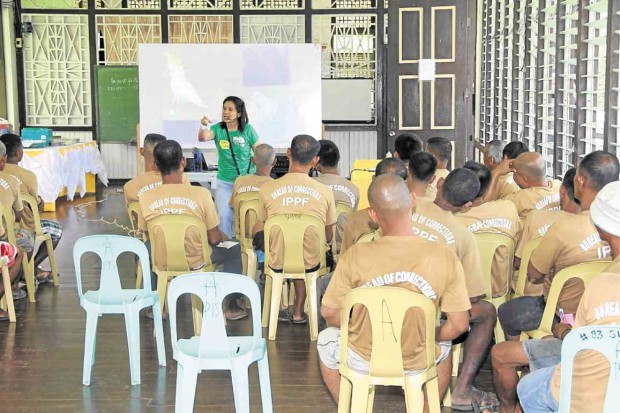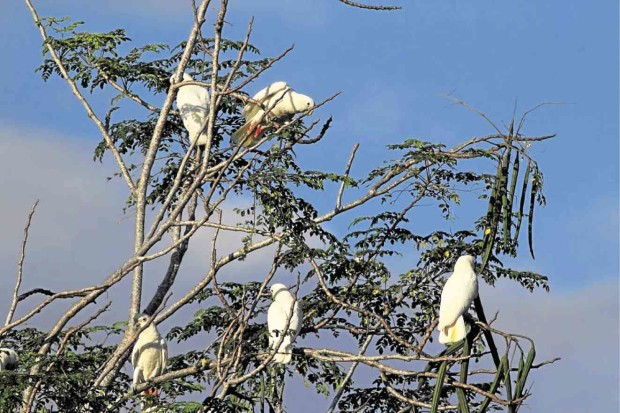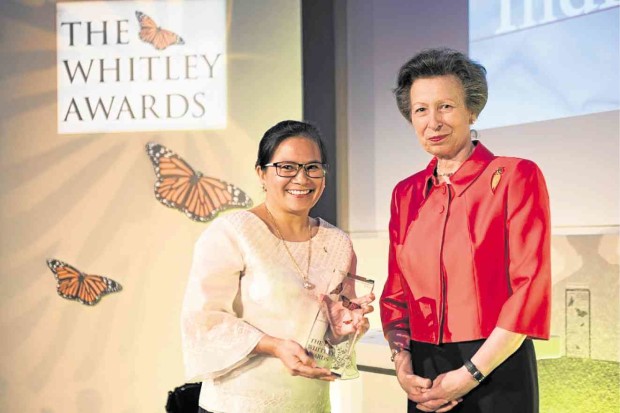Taking an endangered bird under her wing
PUERTO PRINCESA CITY — Once feared to be on the brink of extinction, the Philippine cockatoo, also known as katala, is slowly thriving, thanks to an environmentalist whose work with the iconic bird’s remaining wild population in Palawan province won her the “Green Oscars” of the conservation community.
Indira Lacerna-Widmann, director of the Philippine Cockatoo Conservation Program, last week received the prestigious Whitley Awards in London, conferred by Princess Ann, along with six other environmentalists from different countries.
The award from the Whitley Fund for Nature recognizes “effective local conservationists from biodiversity-rich, resource-poor countries who are spearheading innovative work to save endangered wildlife, and benefit local communities.”
“It is rewarding to see the fruits of what we have achieved,” Widmann told the Inquirer following the awarding ceremonies held at the Royal Geographic Society in London.
Near extinction
Article continues after this advertisementThe Philippine cockatoo or red-vented cockatoo (Cacatua haematuropygia) is classified by the International Union for the Conservation of Nature as critically endangered.
Article continues after this advertisementScientific studies have shown that since the early 1980s, the bird’s population has declined by 80 to 90 percent due to illegal wildlife trade and the destruction of their habitat.
Widmann and her biologist husband, Peter, launched a bid to save the local cockatoo in 1998 by forming the nongovernment organization, Katala Foundation Inc., and settling in the province for good.
“Peter is the culprit. He believed so much that I could help him realize his dream of saving a bird he had introduced me to,” said Widmann who has a master’s degree in environmental studies from the University of the Philippines in Los Baños, Laguna province, and a diploma on conservation education from Durrell Institute of Conservation and Ecology at University of Kent in Canterbury.
The couple’s work began on the island of Rasa off the municipality of Narra, 60 kilometers south of the provincial capital of Puerto Princesa City.
Only about 25 birds were left on the island, which was in fact the largest cockatoo population anyone can find in the entire country.
Today, Rasa Island has a thriving population of over 300 birds, allowing Widmann’s group a chance to expand their work to other parts of the province.

Widmann talks about the endangered bird to prisoners at the Iwahig Prison and Penal Farm in Palawan. —CONTRIBUTED PHOTOS
Work challenges
With limited funding support, the biologist couple adopted practical and cost-efficient strategies to achieve their goal, including partnering with communities and getting them to understand and embrace the importance of conservation.
While rampant poaching and the destruction of the bird’s natural habitat are considered the biggest threats to the cockatoo, Widmann said that educating communities proved to be an effective counterstrategy.
“It is very rewarding to see that (the poachers-turned-wardens) feel proud of what they had achieved,” she said.
On Rasa Island, Widmann fought hard alongside communities in Narra to block a plan some three years ago to put up a coal-fired power facility close to the protected habitat.
Local ownership
“The fight against the coal plant was a heartbreaking experience. But support from the community and local government was overwhelming. It was like the birds whispered to me and told me that indeed, we were all interconnected,” she said.
Local opposition to the proposed coal plant site forced the proponent to find another location for its power facility.
Even with several challenges facing Widmann and her group, the bird’s population continues to recover.
“We have averted the worst scenario, which is the extinction of the species,” declared this Whitney awardee.
“The success story of the recovery of the katala and the sense of local ownership to what we are doing are very rewarding. They affirm that genuine community participation is a must and not an option,” she added.
Widmann vowed to continue working to push local governments to be more aware of the need to conserve the forest habitat of the endangered bird.
“It will really be great if local governments take a more active role in species—and biodiversity conservation,” she said.
Widmann said her group would use the 35,000-euro prize that went with her award to fund similar conservation efforts, this time at the Iwahig forests, by working with prison authorities at the penal facility that occupies the property.


